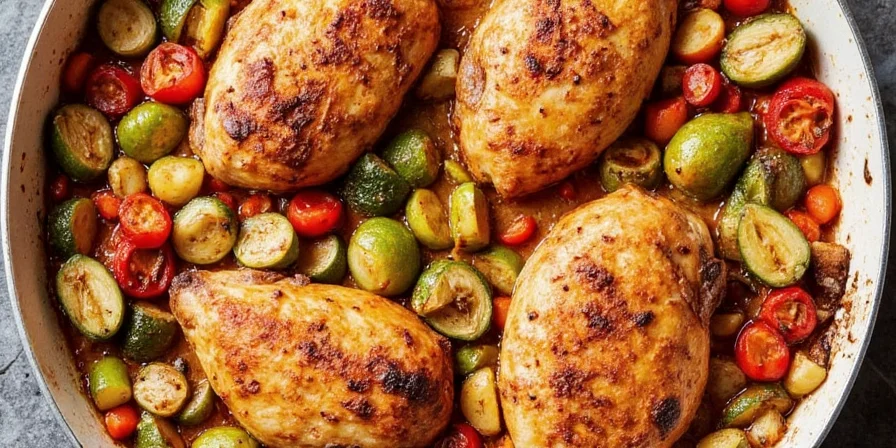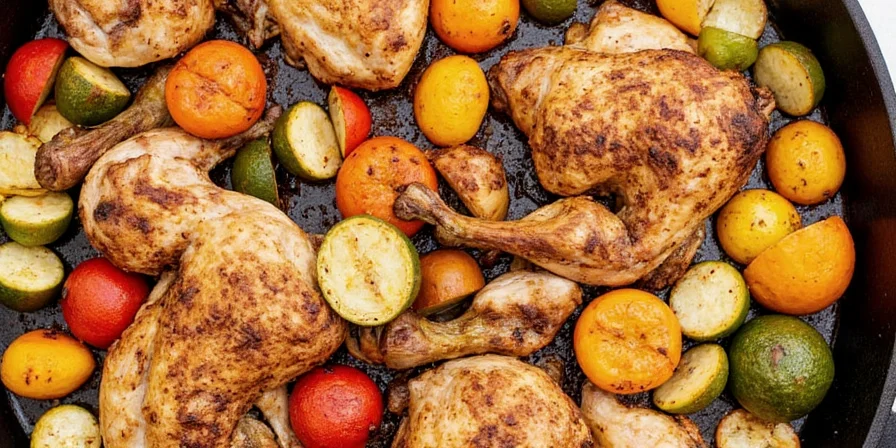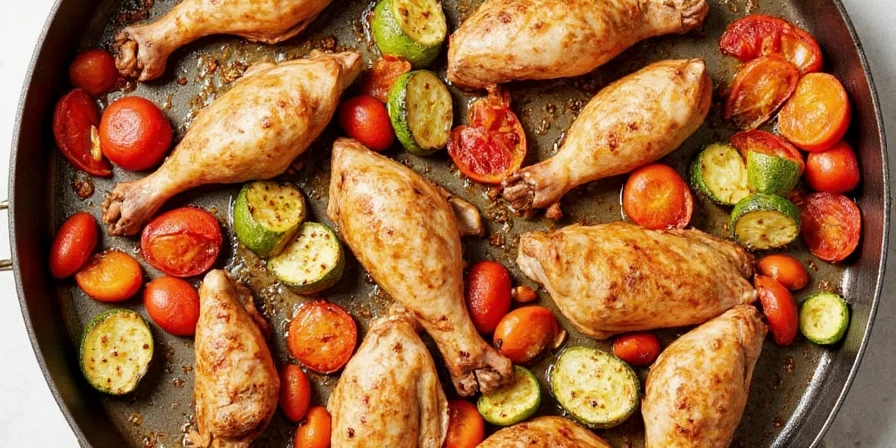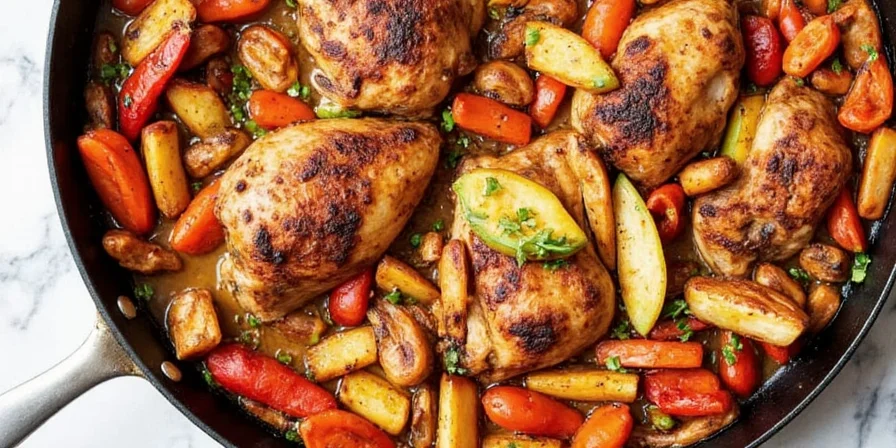Perfect one-pan roasted chicken and vegetables requires just 15 minutes of prep, one baking sheet, and these proven techniques. Skip the guesswork with our step-by-step method that guarantees crispy chicken, tender vegetables, and balanced flavors every time—no special equipment needed. Here's exactly how to make it:
Basic One-Pan Roasted Chicken and Vegetables Recipe
Ingredients: 4 bone-in chicken thighs, 1.5 lbs mixed vegetables (potatoes, carrots, broccoli), 2 tbsp olive oil, 1.5 tsp smoked paprika, 1 tsp garlic powder, 1 tsp onion powder, 0.5 tsp citric acid, salt and pepper to taste
Method: Toss vegetables with 1 tbsp oil and dry spices. Arrange on baking sheet. Rub chicken with remaining oil and spices. Place chicken skin-side up on top of vegetables. Roast at 400°F for 35-40 minutes until chicken reaches 165°F internally.
This simple formula works because it addresses the #1 problem home cooks face: uneven cooking and flavor distribution. The following science-backed techniques explain why this method succeeds where others fail, with actionable adjustments for perfect results every time.
目录
- Why Standard Spice Methods Fail in One-Pan Cooking
- Timing Technique #1: Match Spices to Cooking Phases
- Timing Technique #2: Zone-Based Marinating
- Timing Technique #3: Layered Flavor Building
- Timing Technique #4: Regional Blend Adjustments
- Timing Technique #5: 5-Minute Post-Roast Fix
- Putting It All Together: Foolproof Workflow
- Frequently Asked Questions
Why Standard Spice Methods Fail in One-Pan Cooking
Most home cooks make these three critical mistakes when roasting chicken and vegetables together:
- Applying all spices at once (causes bitter notes in vegetables)
- Using wet marinades (dilutes flavors in shared pan juices)
- Adding herbs too early (creates woody texture from steam exposure)
The solution lies in understanding how different spices behave at various cooking stages. By timing your spice application correctly, you prevent flavor migration while ensuring each component gets optimal seasoning.
Timing Technique #1: Match Spices to Cooking Phases

Success comes from applying spices at their optimal moments during cooking. Follow this proven schedule:
| Spice Type | When to Apply | What It Solves |
|---|---|---|
| Smoked paprika, turmeric | Before roasting | Prevents color loss in pan juices |
| Cumin, coriander | Dry-toast before adding | Eliminates bitter aftertaste |
| Fresh rosemary, thyme | Last 15 minutes | Keeps herbs vibrant, not woody |
| Cayenne, black pepper | After roasting | Ensures even heat distribution |
| Fennel, anise | Midway through cooking | Enhances natural sweetness |
Timing Technique #2: Zone-Based Marinating

Instead of marinating everything together, separate your components:
- Chicken zone: Coat with oil-based spice mix 20 minutes before cooking—any longer makes chicken tough
- Vegetable zone: Toss root vegetables with dry spices 10 minutes before roasting; add delicate veggies halfway through
- Bridge trick: A single teaspoon of honey in the chicken marinade connects flavors without sweetness
This method prevents vegetable juices from washing away chicken seasoning while allowing complementary flavors to develop. It's the secret to balanced seasoning across all components.
Timing Technique #3: Layered Flavor Building

Build flavors in stages to avoid muddied results:
- Pre-heat: Rub pan with garlic oil—creates subtle flavor base that won't overpower
- Pre-roast: Salt chicken skin 45 minutes ahead—draws out moisture for crisp skin despite vegetable steam
- Mid-roast: Add toasted whole spices when veggies are 75% done—infuses flavor without burning
- Post-oven: Rest chicken 8 minutes before adding fresh herbs—preserves bright flavor notes
This sequence solves the biggest challenge of one-pan cooking: synchronizing flavor development across ingredients with different cooking times.
Timing Technique #4: Regional Blend Adjustments

Popular spice blends need tweaks for one-pan success:
- Za'atar: Reduce sumac by 30%—too much reacts poorly with potato starches
- Garam Masala: Skip cardamom with cruciferous veggies—creates bitter flavors
- Harissa: Replace liquid with paprika paste—prevents soggy vegetables
- Old Bay: Increase celery salt with poultry—balances sweet carrots
- Perfect starter blend: 2 parts toasted cumin, 1 part mustard powder, 0.5 part fenugreek
These small adjustments preserve authentic flavors while preventing common one-pan disasters.
Timing Technique #5: 5-Minute Post-Roast Fix

The critical window after roasting makes or breaks your dish. Fix common issues:
- Bland vegetables? Sprinkle lemon zest (not juice)—neutralizes oil separation without adding liquid
- Missing dimension? Crush pink peppercorns—adds complexity without heat
- Flavors not connecting? Sprinkle toasted fennel pollen—bridges chicken richness to vegetable sweetness
- Herbs wilted? Cover with herb bouquet for 90 seconds—infuses without wilting
- Always check chicken temp before finishing—undercooked protein alters spice perception
These quick fixes compensate for flavor equalization that happens when ingredients share roasting space.
Putting It All Together: Foolproof Workflow
Follow this simple sequence for guaranteed success:
- Prep vegetables and apply dry spices 10 minutes before cooking
- Marinate chicken separately with oil-based spice mix
- Arrange vegetables on pan, place chicken on top
- Add stable spices before roasting
- Add medium-heat spices midway through cooking
- Apply finishing touches in the 5-minute post-roast window
This method transforms kitchen uncertainty into reliable results. The next time you roast chicken and vegetables, test just one timing technique. Notice how small adjustments create dramatically better flavor balance. You'll gain confidence to experiment with your favorite spice combinations while avoiding common pitfalls.
Frequently Asked Questions
Q: Why do my one-pan roasted vegetables taste bland compared to chicken?
A: Vegetables release water during roasting, diluting surface spices. Apply dry spice blends directly to vegetables 10 minutes before roasting—this creates a protective barrier that prevents flavor washout while allowing gradual infusion.
Q: Can I use fresh spices instead of dried for one-pan roasting?
A: Fresh spices behave differently under dry heat. Use fresh garlic or ginger only in oil-based marinades (not direct application) as their moisture content causes steaming rather than roasting. For herbs, add delicate varieties like basil post-roast, while hardy herbs like rosemary work best added mid-cooking.
Q: How do I prevent spices from burning in the bottom of my pan?
A: Create a thermal buffer by placing hearty vegetables like potatoes or squash directly on the pan surface before adding protein. Their starch content absorbs excess oil while shielding spices from direct pan heat. Always use oven-safe pans without non-stick coatings which accelerate burning.
Q: Which spice combinations work universally across different proteins and vegetables?
A: The foundational quartet: smoked paprika (heat-stable color), mustard powder (binds flavors), onion powder (umami base), and a touch of citric acid (balances richness). This combination adapts to poultry, fish, or tofu while complementing root vegetables, cruciferous greens, and squashes without requiring recipe-specific adjustments.











 浙公网安备
33010002000092号
浙公网安备
33010002000092号 浙B2-20120091-4
浙B2-20120091-4